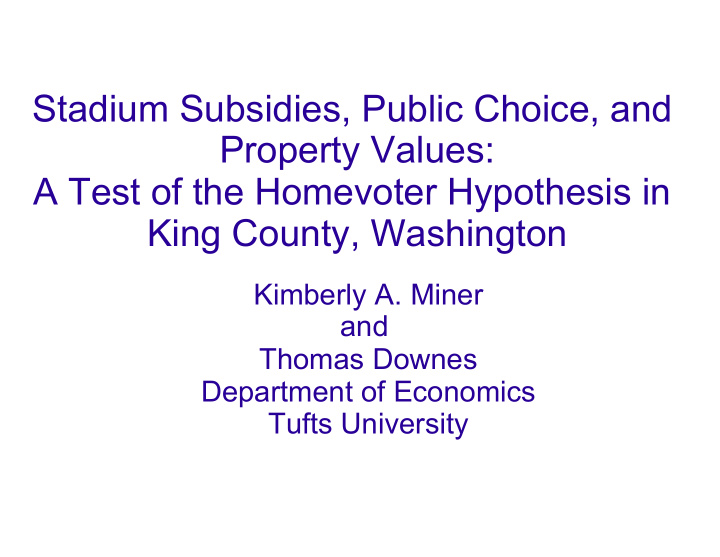



Stadium Subsidies, Public Choice, and Property Values: A Test of the Homevoter Hypothesis in King County, Washington Kimberly A. Miner and Thomas Downes Department of Economics Tufts University
Introduction l The case: The referendum on a new stadium for the Seahawks l The goal: Understanding the yes vote Evidence on costs and benefits of projects l No vote in previous referendum l l The home-voter hypothesis as an explanation l Problem: Tangible benefits v. unobserved attitudes l The twist: Using the previous vote to account for unobserved preferences
Literature l Can intangibles explain favorable votes? - Evidence from surveys l What about tangible benefits? - Evidence from hedonics literature l Could the votes be an example of concentrated benefits, diffuse costs - The home-voter hypothesis l General evidence on the hypothesis l Application to support for public subsidies - Dehring, Depken, and Ward (2008) and Cowboys Stadium
Context l Vote on public subsidies for new stadium for the Mariners (1995) l Paul Allen's purchase of the Seahawks (1996-1997) l Important announcements New stadium as only option l Approval of funding proposal l l Details of funding proposal l Results of the vote
Data l Core data for hedonics: Property transactions from King County Department of Assessments l Use of GIS – Distance from stadium, placement in 1997 precinct l Property attributes – Current, attributes in 2001, attributes in 1997 l Precinct-level data from Decennial Census l Core data for vote analysis: Precinct-level results from 1995 and 1997. Base precincts: 1997.
Empirical Approach l Two-step process – Use results from hedonics to see if percent yes is higher in precincts with more rapid property growth after announcements. l Hedonic model – Supplement standard model with distance to stadium, announcement dummies, and interactions of distance with annoucements (1) ln(Price i ) = ß 0 + ß1Dist i + ß 2 Dist 2 i + ∑ 3 j=1 ß j Dist i *Annc j + ∑ 3 j=1 l ß j Dist 2 i *Annc j + ∑ 17 k=1 ß k Month i + Γ Char + v i l Data don’t support repeat sales but do include rich set of neighborhood controls, house characteristics l Construct announcement effects from results
Evaluating Robustness of Voting Results l Voting models – Relate Percent Yes and Voter Turnout to precinct demographics, announcement effects, and results of the 1995 referendum (to control for unobserved attitudes towards subsidies (2) PctYes i = ß 0 + ß 1 Annc1_Effect i + ß 2 Annc1_ZeroSales i + l ß 3 Annc2_Effect i + ß 4 Annc2_ZeroSales i + ß 5 StadDist i + ß 6 PctTurnout_1995Mariners + Γ Demographics + v i l Estimated similar model with voter turnout as the dependent variable to see if voters with large benefits are more likely to take the time to vote l Focus on coefficients on the announcement effects and on how those coefficients change when we control for support in the previous election
Results - Hedonics l Table 7 presents results l Most standard variables have expected effects on house prices. l U-shaped relationship between prices and distance from stadium l No consistent evidence that prices were affected by announcements – weak effect of first announcement, no impact of second announcement (Table 8)
Results - Voting l Table 9 for Percent Yes, Table 10 for Turnout l Evidence for announcement effect sensitive to inclusion of information from 1995 vote – accounting for unobservables weakens argument for relevance of homevoter hypothesis in Percent Yes regressions l In Turnout regressions, accounting for 1995 vote strengthens case for homevoter hypothesis – some evidence that turnout may be higher in precincts with positive announcement effects in aftermath of funding proposal
Conclusions l Vote in Seattle provides weak support, at best, for the homevoter hypothesis – contrast with results of Dehring, Depken, and Ward (2008) l Importance of accounting for unobservables – unique opportunity provided by the two referenda l Where to go from here? l Improve the hedonics l Better ways to account for unobservables?
Recommend
More recommend